Click image for BBB rating
See our Privacy Policy
cool="cool" width="852" height="19208" border="0" cellpadding="0" cellspacing="0" gridx="16" showgridx="showgridx" usegridx="usegridx" gridy="16" showgridy="showgridy" usegridy="usegridy" bgcolor="#99ccff">
|
|
|
|
 |
|
|
|
|
|
|
|
|
Welcome to Spaightwood Galleries, Inc.
120 Main Street, Upton MA 01568-6193
You can follow us on Facebook and Twitter!
Welcome to Spaightwood Galleries, Inc.
120 Main Street, Upton MA 01568-6193
Old Master Drawings: 16th-Century Italian Drawings
SCROLL DOWN FOR MORE
|
|
|
|
|
|
Thinking and looking at our drawing inventory, we began thinking about the variety of our drawings and the various purposes for which they were made. In this show we want not merely to show some extraordinarily beautiful drawings but also to invite viewers to consider some of the many kinds of drawings, the multiplicity of uses of drawings, and the varying degrees of artistry of drawings. Because, particularly in the case of earlier masters, drawings were sometimes intended to be for the use of the artist and his assistants, remaining as valued property of the workshop for years, they are not always clearly identified on the sheet and attribution becomes a matter of interpretation. For one example, see the page on Pier Francesco Mola; for another, we offer the commentary below from Diane De Grazia, Correggio and His Legacy: Sixteenth-Century Emilian Drawings (Washington: National Gallery of Art, 1984): "The Brussels drawing is catalogued as a Zuccaro, but Anthony Blunt has suggested that it is the work of Francesco Vanni. However the application of red and black chalk is typical of Federico, and an attribution to him can be made with some security, Although the facial features of the more finished figures reflect those of Corregio, several of the lightly sketched angels in the background betray Federico's hand." As the history of the attribution of Rembrandt's paintings over the past forty years by a select committee trying to establish a definitive canon of his works, in which his numbers first sunk from a total of about 700 down to nearly 300, and have since risen to about 500 suggests, even experts can disagree and often the attributions of old master paintings and drawings may change from decade to decade even within the same museum based upon both the current state of knowledge about both artist and period and upon the changing knowledge of the expert doing the attributing.
For an analysis more specifically focusing on sixteenth-century Italian drawings, see the introductory remarks to our 2010-11 exhibition of old master drawings.
|
|
|
|
Giorgio Vasari, whose prime loyalty was always to Michelangelo, offers his ultimate praise at the beginning of his Life of Michelangelo in The Lives of the Artists, published in 1568. The first paragraph sets the tone of the 84 pages that follow: "While industrious and choice spirits, aided by the light afforded by Giotto and his followers, strove to show the world the talent with which their happy stars and well-balanced humors had endowed them, and endeavoured to attain to the height of knowledge by imitating the greatness of Nature in all things, the great Ruler in Heaven looked down and, seeing these vain and fruitless efforts and the presumptuous opinion of man more removed from truth than light from darkness, resolved, in order to rid him of these errors, to send to earth a genius universal in each art, to show singlehanded the perfection of line and shadow, and who should give relief to his paintings, show a sound judgment in sculpture, and in architecture should render habitations convenient, safe, healthy, pleasant, well-proportioned, and enriched with various ornaments. He further endowed him with true moral philosophy and a sweet poetic spirit, so that the world should marvel at the singular eminence of his life and works and all of his actions, seeming rather divine than earthly" (Everyman edition, vol. 3, 108). During the sixteenth century, Michelangelo bestrode the art world like a colossus, and artists desperately sought to learn how to understand his works by making drawings of them and studying them, seeking there inspiration and the ability to please patrons who demanded they achieve the effects that Michelangelo's paintings and sculptures had. Michelangelo's own drawings ranged from quick sketches, proposals from commissions mixing his hand-written ideas with sketches, working drawings for paintings and sculptures, proposals for ornaments, architectural projects, and presentation drawings for his friends. On occassion he also gave drawings to artists to use as a basis of their own compositions (see The Death of Phaeton below).
Select Bibliography: Charles de Tolnay, Michelangelo. 5 volumes (Princeton: Princeton University Press, 1943-1960; rpt. 1968); J. A. Gere, Drawings by Michelangelo in the Collection of Her Majesty the Queen at Windsor Castle, The Ashmolean Museum, The British Museum, and other English Collections (London: The British Museum, 1975); J. A. Gere, Drawings by Michelangelo from The British Museum (NY: The Pierpont Morgan Library, 1979), Paul Joanides, Michelangelo and His Influence: Drawings from Windsor Castle (Washington D.C.: The National Gallery of Art, 1996); Paul Joanides, The Drawings of Michelangelo and His Followers in the Ashmolean Museum (Cambridge: Cambridge University Press, 2007).
|
|
|
|
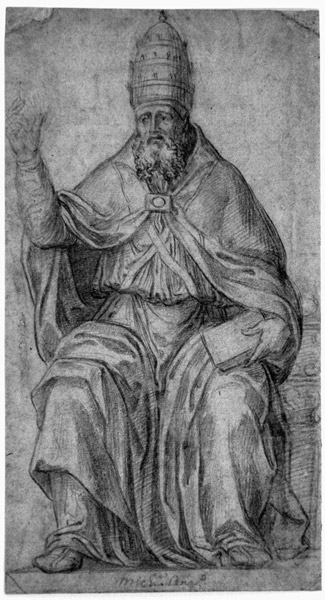 |
|
|
|
|
After Michelangelo, Pope Clement VII Blessing. Pencil on old laid paper after a design by Michelangelo. Charles De Tolnay, Michelangelo: The Medici Chapel Vol. 3 (Princeton: Princeton University Press, 1970), prints several works ( figures 314-323) apparently modelled after Michelangelo's lost design for a sculpture for the project on the Medici Dukes and Popes (Leo X and Clement VII). Figure 315 presents the Monument of Pope Clement VII by Antonio da Sangallo and Bandinelli in Santa Maria Sopra Minerva in Rome, a sculpture possibly modelled upon the original of this drawing. The Medici Dukes ended up with their own monument in the Medici Chapel at San Lorenzo in Florence; the Popes are in Rome. The idea was first discussed in 1520 and Michelangelo worked on it, off and on, until Clement VII's death in 1533, when the new Pope, Paul III ordered him to paint the Last Judgment for the Sistine Chapel and two large frescoes for the Pauline Chapel, The Calling of St. Paul and The Crucifixion of St. Peter. Our drawing is inscribed "Michelangelo" at the base. Our hypothesis is that someone saw Michelangelo's apparently lost original drawing and copied it, the norm for any work of Michelangelo to anyone vouchsafed a view. Image size: 231x125mm. Price: Please call or email for current pricing information.
|
|
|
|
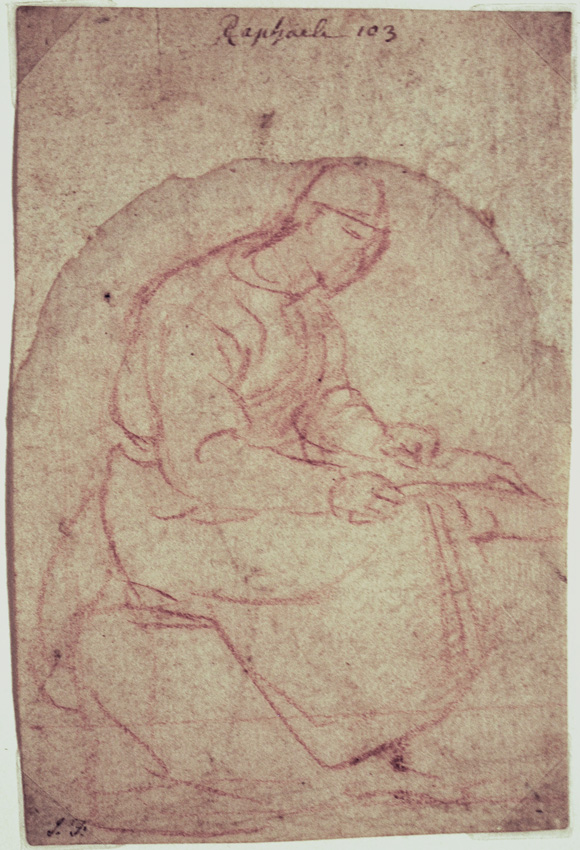 |
|
Raphael Sanzio (Urbino 1483-1520 Rome), Attributed, Seated figure. Red chalk on old laid paper, c. 1504. Inscribed "Raphael 103" top center; initialed "J. F." in black ink lower left corner. Provenance: letter from Edward G. Hawks, a lawyer from Buffalo NY dated 12/25/1898 to James Dudley Hawks of Detroit MI, describing finding this and two other drawings loosely inserted in a 4-volume set of engravings of Herculaneum (Rome, 1789) with a note on the inside front cover, "Maria Denman–from her affectionate Brother [in-law] and Friend, John Flaxman." Flaxman (1755-1826) was a member of the Royal Academy, a successful sculptor and draftsman; he provided drawings to be engraved by artists (including William Blake) illustrating various texts including the Iliad, the Odyssey, the works of Aeschylus, and the Divine Comedy. Flaxman was in Rome from 1787 to 1794, where he would have had access to drawings by Raphael; Flaxman's own drawings, "unusual at the time for being conceived almost entirely in terms of outline," (Grove Dictionary of Art 11: 162-65; here at 163) might well have made Raphael's drawings of interest to him not just aesthetically but also practically. According to Hawks, he sent this drawing and two others (one of which, The Adoration of the Magi, here attributed to Parmigianino, Hawks calls the "The wise man's offering," misreading the title written on the verso in Flaxman's hand, "The wise men's offering," we have also purchased) to his brother, "hoping they will afford you amusement and profit." Image size: 136x90mm.
On our 27" monitor, this is about life size.
|
|
|
|
|
|
The drawing seeems to relate to Raphael's drawings made at Pintoricchio's request (c. 1504) for him to use in his fresco cycle on the life of Pope Pius II in the Duomo in Siena (Vasari, II: 223 [Everyman edition]). In particular, see the 4th fresco, in which the future Pope Pius II is sent by the Emperor Frederick III to Pope Eugenius IV. The fresco shows Aeneas Silvius kneeling in front of the Pope to kiss his slipper; on either side of the Pope there are five seated clerics wearing robes similar to those worn by the figure in our drawing. In an essay published in The Cambridge Companion to Raphael, Bette Talvacchia uses Vasari's Life of Giulio Romano, Raphael's former chief assistant, to suggest what Raphael's workshop practise must have been like: "In assigning his assistants a more substantial role in the labor-intensive procedure of turning out hundreds of preparatory drawings for frescoes, Raphael initiated them into a rigorous working method, which they perpetuated as independent masters. The process devised by Raphael was to execute preliminary, rough sketches, proceed with further consideration of the groupings and individual figures through studies from life (often garzoni in appropriate poses), and then combine the compositional arrangements with the figural studies to form modelli" (p. 178); for an example of using memebers of his workshop as models, see Thomas P. Campbell, Tapestry in the Renaissance: Art and Magnificence (NY: Metropolitan Museum of Art, 2002), figure 21, p. 208; for the process by which the tapestries were designed and realized for the tapestry makers in Brussels, see pp. 189ff . Our drawing seems to be just such a rough sketch (perhaps of one of the workshop assistants), to get the feel of a seated figure seen from the side. For a similar use of chalk to outline a figure, see Joannides 1983 #17, upper left. For the Pinturrichio frescoes, see either The Piccolomini Library in the Cathedral of Siena: The History of Pope Pius II in the Ten Frescoes of Pinturicchio (Siena, 1938) or Pietro Scarrpellini, Pintoricchio all Libreria Piccolomi (Milano: Fratelli Fabbri, 1965), p. 22. For additional seated cardinals in similar garb (though in different postures, see p. 38). For a reproduction of one of Raphael's cartoons, see Rhoda Eitel-Porter, ed. From Leonardo to Pollock: Master Drawings from the Morgan Library (NY: The Pierpont Morgan Library, 2006), pp. 26-27.
|
|
 |
|
|
|
Giulio Romano (Giulio Pippi; Rome 1499-1546 Mantua), attributed, Scipio rewarding his soldiers. Drawing in pen and brown ink with brown wash. Although he may have begun working on the story of Scipio Africanus as early as 1522-23, at some time prior to 1532 Giulio accepted a commission to design 2 sets of tapestries for François I, King of France on the theme of the Deeds and Triumphs of Scipio. A 22-piece set was made in Brussels between 1532 and 1535 and delivered in parts as they were finished during those years. Another payment was made to Giulio's pupil Francesco Primaticcio, who had arrived at Fontainebleau shortly after 22 March 1532 to travel from France to Flanders, "where he had to carry a modello of the story of Scipio the African, intended for a tapestry that the king was having made in Brussels, and to bring back the cartoon of the said story" (cited in Campbell 343). Campbell's figure 150 shows a preparatory drawing by Giulio that the Musée du Louvre dates c. 1522-1523(?) and that shows The Capture of Carthage in pen and brown ink with brown wash similar to ours. Another of Giulio's drawings for the Acts, The Triumphal Feast of Scipio, is published in Martin Clayton, Raphael and his Circle: Drawings from Windsor Castle (London: Merrell Holberton, 1999), plate 37. Aside from several wormholes lower right corner, center-left bottom, in the thigh of the left-most soldier, in the base of Scipio's throne, and top right and center right, all repaired and all backed with tinted paper, the sheet is in very good condition. For Diana Scultori's engraving of The Clemency of Scipio after Giulio Romano, which may be based upon another of Giulio's designs for the Acts of Scipio, click here. Image size: 276x184mm. Price: Please call or email for current pricing information.
|
|
|
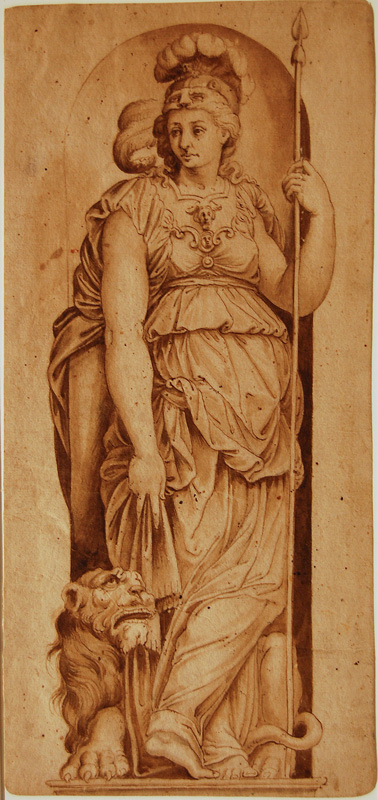 |
|
|
|
Perino del Vaga (Pietro Buonaccorsi; Florence, 1501-1547 Rome), attributed, Fortitude. Pen and brown ink and wash on heavy laid paper, c. 1545. Perino joined Raphael's workshop around 1516, working on the Vatican Loggia. Vasari notes that Perino's studies (especially his studies of Michelangelo's cartoons in the Sistine Chapel), soon led him to become "the best designer in Rome, with a better understanding of the muscles and the difficulties of nude figures than any, perhaps even among the best masters" Lives, trans. A. B. Hinds, 4 volumes (London: Everyman, 1970), III, 122. It also led Raphael, hearing his praises from Giulio Romano and Gio. Francesco il Fattore, to employ him in the Vatican (Vasari, III, 122). After Raphael's death, he worked on several fresco schemes in Rome before being captured in the Sack of Rome and being forced to pay a huge ransom that impoverished him and led him to move in 1528 to Genoa in the service of Admiral-Prince Andrea Doria and then to Pisa (c. 1534). About 1537, he returned to Rome and become Pope Paul III's principal painter (Michelangelo's efforts on The Last Judgment for the Sistine Chapel and The Crucifixion of St. Peter for the Pauline Chapel not permitting him time to do anything else for the Pope). Perino executed frescoes of the Four Cardinal Virtues in the Sala Paolina in the Castel Sant'Angelo in Rome. No other studies of Perino's Fortitude are known, although the Met owns his drawing of Prudence in a niche (see J. A. Gere, Drawings by Raphael and his Circle from British and North American Collections (NY: Pierpont Morgan Library, 1987), plate 78. Along with a number of other drawings (including some presently on display at the Metropolitan Museum of Art in an exhibition devoted to Perino del Vaga in New York Collections and featuring the Met's two new acquitions, the drawing and painting by Perino discussed in the NEWS FLASH below), Fortitude and Prudence share a wide, flat big toe; see also Bernice F. Davidson, Mostra di Disegni di Perino del Vaga e della sua cerchia (Florence: Leo S. Olschki, 1966), plates 5, 44, and 45; similar toes may also be found in Perino's drawings reproduced in Gere, plates 67, 71, and 77; for additional examples, click here). For Vasari, in his Life of Perino, the dual tragedies of his life were that "he loved designing better than executing works" (III, 137) and that his poverty forced him to accept so many commissions that he could only do the drawings and was forced to let others paint them: "Having undertaken so much, and being infirm, he could not support his labor, being compelled to work day and night to satisfy the needs of the palace, designing numerous ornaments for the Farnese and other cardinals and lords. He never had an hour's quiet, his mind being constantly occupied, and he was always surrounded by sculptors, stucco-workers, wood-carvers, tailors, joiners, painters, gilders and other artisans [looking for employment]" (Lives, III, 139). Image size: 377x173mm. Price: Please call or email for current pricing information.
|
|
|
NEWS FLASH! Perino del Vaga's works were very much in the newsat the end of January 2011. From The New York Times: "On 26 January 2011, The Metropolitan Museum of Art set a new world record for a drawing by Perino by paying Please call or email for current pricing information for a drawing for a tapestry of Jupiter and Juno Reclining in an Alcove. The prior auction record for a drawing by Perino was Please call or email for current pricing information. The next day, the Met bought The Holy Family With the Infant St. John the Baptist,” a painting by Perino, for Please call or email for current pricing information million. It had been expected to bring Please call or email for current pricing information to Please call or email for current pricing information. "It was a double sweep,” Keith Christiansen, the Met’s chairman of European paintings, said in a telephone interview. “Perino del Vaga is one of the very great Renaissance draftsmen, but the minute I saw this painting, I nearly keeled over.”
|
|
|
|
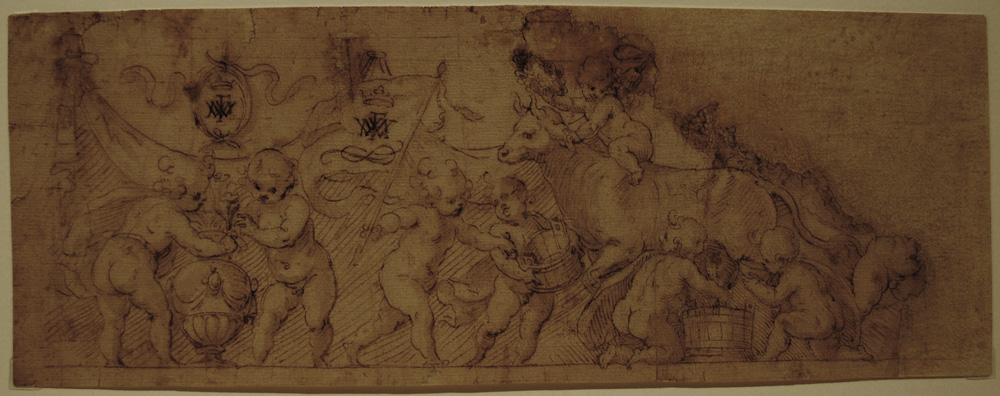 |
|
|
|
|
|
Raphael Workshop, Fragment: Putti at work and play. Pen and brown ink and wash on laid paper, c. 1515-25. Seven putti are busy at work putting flowers into a vase almost as big as each of them while five more are playing with a large cow: one riding it and putting a wreath on its head, perhaps for a sacrifice, two others are milking it, and two more are bringing another bucket over to continue the job. Part of another is visible at right in the damaged area, which extends upward over to the head of the putto putting the wreath on the cow. There are coats of arms top left and center: "MWF" within a cartouche surmounted by a crown and again next to it on a standard. The scene seems similar to Giovanni da Udine's designs for a tapestry Triumph of Love executed by Raphael's workshop (Giovanni, Perino del Vaga, Giulio Romano, and Giovanni Francesco Penni). See Thomas P. Campbell, Tapestry in the Renaissance: Art and Magnificence (NY: Metropolitan Museum of Art, 2002), pp. 189ff for the process by which the tapestries were designed and realized for the tapestry makers in Brussels. With regard to the set of tapestries showing the Acts of the Apostles for the Sistine Chapel, where they would be hanging beneath Michelangelo's ceiling frescoes, Campbell suggests that Raphael would probably have wanted to design the cartoons himself, but suggests that he might have then delegated the final elaboration of the cartoons to his workshop based upon his designs (although he notes that "several of the drawings relating to the preliminary process for at least The Charge to Peter are by Raphael's pupils" [ p. 190]). However with the next set of tapestries for the Pope, The Triumphs of the Gods, "which was the first tapestry series in which the grotesques were applied as an all-over decorative formula" (p. 228), the rules appear to have changed. Following Vasari's statement that Raphael assigned the designs to Giovanni da Udine, Campbell suggests that although Giovanni may have been in charge of the "fanciful grotesque decorations," other artists who almost certainly must have been involved were Giovanni Francesco Penni and Perino del Vaga" and that since "so much of Penni's work seems to have been based upon compositional sketches by Raphael and Giulio Romano, we might also suspect that Giulio played a part in the conception of some of the figural groups" (p. 228). After the Grotesques, Raphael's studio turned to another set of designs for tapestries, the Giochi di Putti. In these works, again, the putti's antics are the central design feature of a twenty-piece set ordered by Pope Leo X featuring "Children at play and devices symbolic of his rule against a rich background of gilt-metal thread" (pp. 229-230). Since the tapestries for The Triumphs of the Gods and the Giochi di Putti are lost and all that survive are some of the cartoons, it is impossible to say with any certainty that our work may have been a part of either set, though the format of the drawing clearly fits the format of the tapestries and the images are appropriate to the description in the Papal inventories of "putti playing" and the style is appropriate for the works of Raphael's workshop. Partly pricked for transfer lower right. Cf. Marco Dente da Ravenna's 1519 engraving Bas Relief with Three Cupids reproduced in Tapestry in the Baroque: Threads of Splendor, ed. Thomas P. Campbell (NY: Metropolitan Museum of Art, 2002), p. 401. Image size: 135x335mm. Price Please call or email for current pricing information.
|
|
|
|
|
|
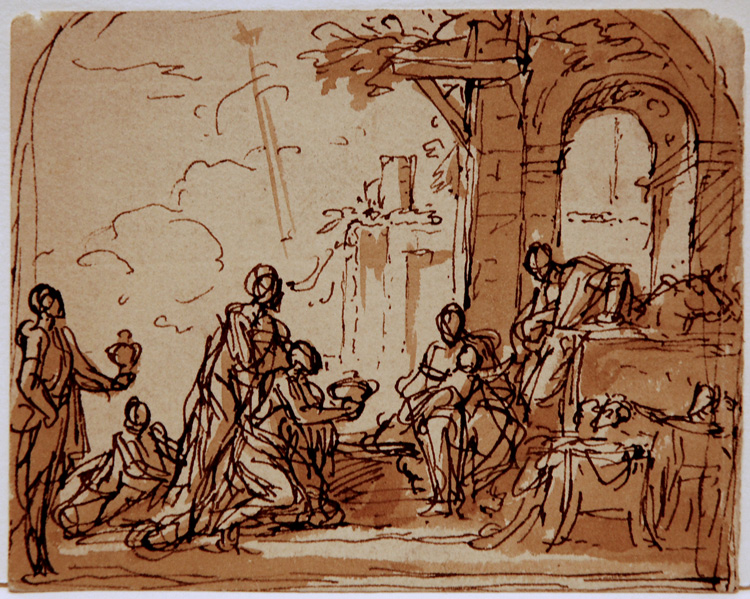 |
|
|
|
Parmigianino, attributed to, The Adoration of the Magi. Pen and brown ink and wash, c. 1526. For a drawing of c. 1526 that exhibits the same look and feel as ours, see plate 37, Christ Healing the Sick, in the new catalogue raisonné of Parmigianino's drawings, by Beguin et al (2000; this is also Popham 5). The drawing is a quick and lively study of the layout of the work in which Parmigianino does not take time to sketch in the features of the individual figures but is more concerned with setting the scene of the appearance of the Magi in a stable surrounded by farm animals and an infant in his mother's arms to which their royalty pays homage. Provenance: John Flaxman R.A., English, 1755-1826; Flaxman worked in Rome 1787-1794. On the provenance, click here for the letter and the reproduction of the verso of the above drawing where it is titled "The wise men's offering" in what looks like Flaxman's handwriting. Image size: 88x110mm. Price: Please call or email for current pricing information.
|
|
|
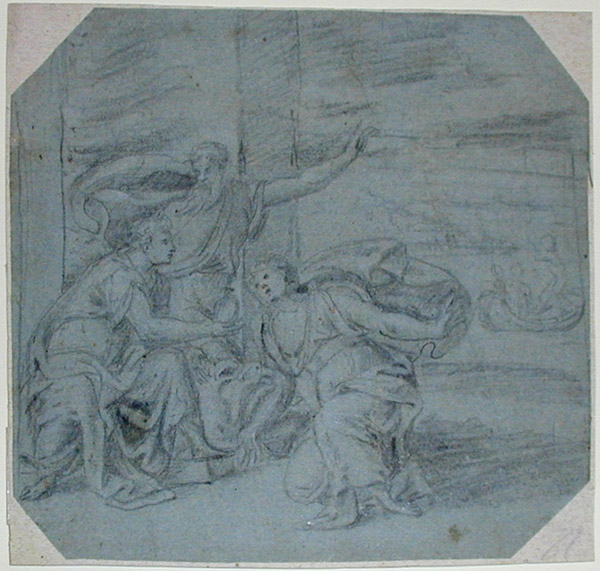 |
|
|
|
Andrea Schiavone (Zara 1510-1563 Rome), Dido receiving word of Aeneas' departure. Black and white chalks on blue laid paper mounted on card stock. Aeneas, obedient to the will of the gods, has just abandoned Dido and sails off in the harbor en route to found Rome. Dido, astounded that her husband has left her without a word, is frozen while all around her the world seems to move in sympathy to the wind that takes Aeneas away from her. (When the stasis ends, she will commit suicide.) This "betrayal" by Aeneas– ordered by Mercury on behalf of Jupiter–wil ultimately be the cause of war between Carthagem Dido's city, and Rome, the city Aeneas is going to found in Italy. Image size: 145x150mm Price: Please call or email for current pricing information.
For more drawings by Schiavone, click here.
|
|
|
Titian, Veronese, and Jacopo Tintoretto dominated the Venetian art scene for most of the 16th century, winning most of the public and religious commissions during that period. The Doges' Palace in Venice is particularly rich in work by Veronese. Veronese's studio was active and works from it were eagerly sought. Sir Philip Sidney, the English poet, diplomat, and soldier, after fleeing the St. Bartholomew Day's massacre in Paris in 1572 went to be mentored by Hubert Languet at the Emperor's Court. Several years later, wanting to commission a portrait for Languet before he went back to Engliand, he went to Venice, where, after visiting the studios of both Veronese and Tintoretto, he commissioned his portrait from Veronese. Veronese was also popular with the nobility, who commissioned works for their villas and studies, often of an allegorical nature.
|
|
|
Tintoretto had a sign in his workshop saying that here could be found "the drawing of Michelangelo and the color of Titian," and it is clearly Titian's color that most 16th-century viewers found overwhelming. Vasari, in his "Life of Titian" (in Part III of The Lives of the Painters, Sculptors, and Architects) reports that Sebastiano de Piombo remarked that "if Titian had gone to Rome and seen the works of Michelangelo, Raphael, and the ancient statues there, and had studied design ("disegno" in Italian combines the meanings of both "drawing" and "design"), he would have produced stupendous things, seeinig his skill in coloring, in which he deserves to be called the best maser of our day for his imitation of natural tints; and with a foundation of great draughtmanship he would have overtaken the Urbinate [Raphael] and Buonarroto [Michelangelo] (Everyman edition, III: 200-201)." Vasari later confirms Sebastiano's judgment by telling of a visit that he and Michelangelo made to Titian's studio in Rome: "After they had gone, Buonarroti criticized Titian's methods, prasing him a good deal, and saying that he liked his coloring and style, but that it was a pity that good design was not taught at Venice from the first, and that her best painnters did not have a better method of study. If this man, he said, were aided by art and design as he is by Nature, especially in copying from life, he would not be surpassed, for he has ability and a charming and vivacious style" (Everyman edition, III: 206-207). Very few of Titian's drawings survive, partly because he worked in oil not fresco and drew directly on his canvases, but despite the criticism of his drawing or lack of it, Titian did not lack noble patrons including the Emperor Charles V, his son, Philip II, the King of Spain, various princes and dukes, popes and cardinals, and a lifetime worth of Venetian Doges. With such a widespread group of admireres, it is not surprising that engravers stepped forward to spread his fame by reproducing his most famous paintings and that woodcutter followed his example in his 1508 epic woodcut of The Triumph of the Faith, a work Vasari categorizes as "displaying vigor, style, and knowledge. The engravings and woodcut below reflect part of the widespread demand for works designed by Titian.
Selcted Bibliography: Roland Krischel, Masters of Italian Art: Jacopo Tintoretto 1519-1594 (Cologne: Konemann, 2000); Tom Nichols, Tintoretto: Tradition and Identity (London: Reaktion Books, 1999 [large- format paperback available for purchase new: Please call or email for current pricing information]); Carlo Ridolfi, The Life of Tintoretto and of his children Domenico and Marietta, trans. Catherine and Robert Enggass (University Park: Pennslyvania State University Press,1984); David Rosand, Painting in Cinquecento Venice: Titian, Veronese, Tintoretto (New Haven: Yale University Press, 1982); Cornelia Syre, ed., Tintoretto: The Gonzaga Cycle (Munich: Hatje Cantz,2000); Jacopo Robusti Tintoretto, La Mostra del Tintoretto (Venezia ca' Pesaro: 1937); Francesco Valcanover, Jacopo Tintoretto and the Scuola Grande of San Rocco (Venice) (Venice: Stoti Edizioni, 1999 [this is the guide book in English to Tintoretto's painting cycle available at the Scuola: large-format paperback available for purchase : Please call or email for current pricing information]); Henri Zerner et al, ed., The Illustrated Bartsch 32: Italian Masters of the 16th Century: Parmigianino, Master F.P., Meldolla, Schiavone, Titian, Marconi, Tintoretto, Bresciano, Franco, P. Farinati, H. Farinati, del Moro, Fontana, Valentinis (NY: Abaris Books,1979).
|
|
|
|
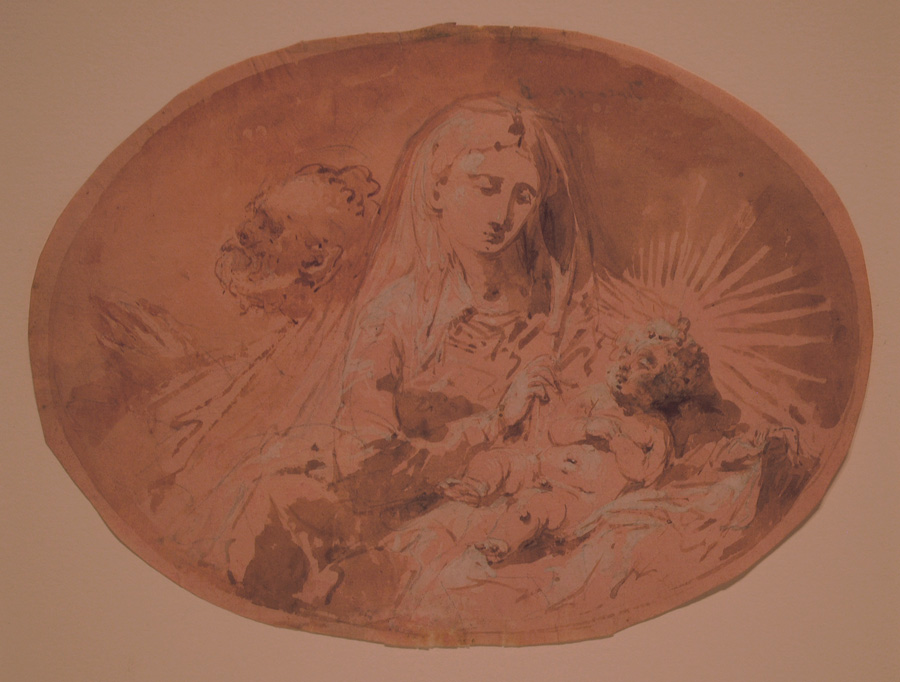 |
|
|
|
Venetian School, The Holy Family. Brush and brownish red ink and pencil with white gouache, Venice, late 16th-early 17th century. A beautiful drawing on thin cream laid paper heightened with a prepared rose wash ground. There is an early attribution to Tintoretto on the verso (visible just above and to te right of the Virgin's head. The rich color and loose drawing make the attribution a possibility. The white areas are much whiter than they appear above. Image size: 140x187mm. Price: SOLD.
|
|
|
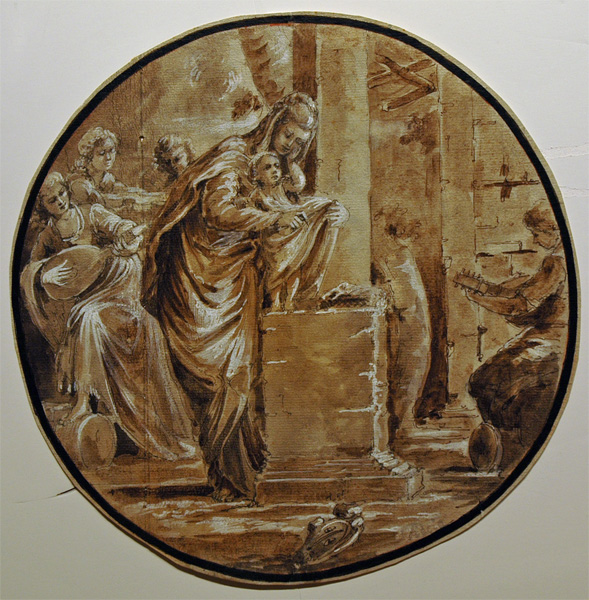 |
|
|
Our drawing is a variant of a drawing in the Louvre by "Paolo Cagliari called Veronese (c. 1528-1588)," titled "Pittura Quarta," and otherwise titled variously Virgin and Child with Musical Angels in the Wilderness (Richard Cocke, Veronese Drawings. A catalogue raisonne [London: Sotheby Publications, 1984], n. 19, p. 76) or The Madonna as a Seamstress (W. R. Rearick, The Art of Paolo Veronese 1528-1588 (Washington DC: National Gallery of Art, 1988), illustrated frontispiece and pp. 164-65. Brown wash base with pen and brown ink and heightening in white body color. Our drawing is on cream laid paper with a watermark close to Briquet 7112 (Salerno 1570) and 7113 (Ferrarra 1570) and a worn collector's mark on verso.
The Louvre's variant, "Pittura Quarta," depicts the Virgin and Child surrounded by six angels in a rectangular format. The Virgin holds what Cocke describes as a "strange implement (a Pair of tongs?)" while Jesus reaches up to caress her face. On the left side, three musical angels in similar positions in a similar arrangement are serenading them; on the right, three more angels play for her, one of whom, seated playing a lute is close to ours, the only one on the right side of our drawing. In the background are the ruins of a building (perhaps the manger). Cocke dates the "splendid series of finished chiaroscuro drawings catalogued together (numbers 17-42) as independent works produced in the 1550s and early 1560s" [p. 21]). Rearick dates it 1583-84 and reproduces it as the frontispiece of The Art of Paolo Veronese 1528-1588 in a full-page illustration and discusses again on pages 164-65 with a smaller illustration. Our drawing is circular, the Louvre's is rectangular. Both are beautiful and well-executed drawings, ours, perhaps a presentation drawing, seems more brilliant, finished and assured. According to Cocke (p. 77, note 7), the Louvre's Veronese remained in Veronese's studio during the artist's lifetime: "That it remained in the studio may be confirmed by the painting in the collection of Antonio Zecchini in Pescara, which measured about the same size as the drawing and was, to judge from the engraving by Diogini Valesi, a studio derivation from the drawing." Our Veronese shows precisely the characteristics that Cock praises: "independent works in preparatory drawings and executed with a brilliance and fluidity in the white heightening that was copied but never equalled." Rearick identifies the "strange implement" as a pair of shears, with which the Virgin is trimming Jesus' garment. This makes sense of the little basket sitting next to Jesus' feet as her sewing basket. His arguments for the later date can be found on p. 165. Rearick's later date finds at least some support in Annalisa Scarpi's remarks on a drawing in pen and brown ink with white lead heigtening that Veronese prepared in connection with his Triumph of Venice for the ceiling of the Sala del Maggior Consiglio above the Doge's throne commissioned 1579 and completed by 1582 (see Giandomenico Romanelli et al, Veronese: Gods, Heroes and Allegories [Milan: Skira, 2004], p. 140; see also p. 142, where Scarpi dates another of the chiaroscuro drawings, The Triumph of Fame over Evil to the 1580s).
Cocke's comments on these chiaroscuro drawings are useful: "The independent chiaroscuro drawings were among the most admired of Veronese's drawings, being the only ones mentioned by his first biographer Ridolfi in 1648. Ridolfi's enthusiasm is understandable, for they were planned as independent works in preparatory drawings and executed with a brilliance and fluidity in the white heightening that was copied but never equaled. Veronese here turned to an older tradition of Venetian drawing with a sense of invention in conventional subjects, both religious and allegorical and in unusal variations on well-established themes (p. 71). If Rearick is correct in his dating and the date of ours is close to the year in which the paper was manufactured, ours is either a variant of another drawing of the scene not yet published or it is the original version of the Louvre's drawing.
One of Veronese's small ink drawings sold at auction at Christie's London on Dec. 5, 2006 for £180,000 (then Please call or email for current pricing information). We offer ours for a bit less than that price. Image size: 285mm diameter. Price: Please call or email for current pricing information.
|
|
|
 |
|
|
|
Paolo Veronese (attributed), Juno and her peacock on a cloud seen from the rear. Brush and brown ink and wash on laid paper, c. 1570. Titian, Paolo Veronese, and Jacopo Tintoretto dominated the Venetian art scene for most of the 16th century, winning most of the public and religious commissions during that period. The Doges' Palace is particularly rich in work by Veronese. Hope, in Veronese and the Venetian Tradition of Allegory, talks about the distinct meanings of Juno in Venetian ceiling paintings in the 1560s-1580: Juno as Venice's patron (see pp. 409, 410); Juno as the element of air (Hope, pp. 415, 416), and Juno as one of the patrons of marriage (Hope, 419 and plate xxvii [b]). See also Pignatti and Pedrocco 1991, p. 111 (Juno clothed on a cloud with her peacock and a putto); p. 130: Juno, Hymen and Venus on a cloud in the Stanza dell'amor coniugale (in the Villa Barbaro at Maser, c. 1561-62?); p. 224, fig. 143d, Juno and Apollo in the Fontego dei Tedeschi in Venice; p. 230, pl. 149b, where the central figure in Infedeltà [Infidelity] (c. 1576-78) is a half-naked female figure seen from behind and below who shares much of the physicality of our drawing; p. 263, pl. 190, The Trionfo di Venezia in the Salo del Maggior Consilio in the Palazzo Ducale in Venice (1579-1582), in which the enthroned figure of Venice is attended by a number of figures, including a crowned female nude seated on a cloud seen from behind and below. See below for another drawing on the verso with an unidentified collector's mark. Image size: 262x188mm. Price: Please call or email for current pricing information.
|
|
|
|
|
|
|
|
 |
|
|
Paolo Veronese (attributed), A man kneeling by a large urn. Brush and brown ink and wash over pencil on cream laid paper. Image size: 137x190mm.
For additional works by or after Veronese, please click here.
|
|
|
 |
|
|
|
Italian School (Venice, mid 16th-century), The Adoration of the Magi. Pen and brown ink and wash on cream laid paper, c. 1550? A very beautiful drawing in poor condition: abrasions lower left, repaired paper loss on the left side above the head of the kneeling Magus and partially obscuring the heads of the other two Magi. The drawing has been restored amd mounted on an archival suport sheet.. Image size: 253x180mm. Price: Please call or email for current pricing information.
|
|
|
|
|
|
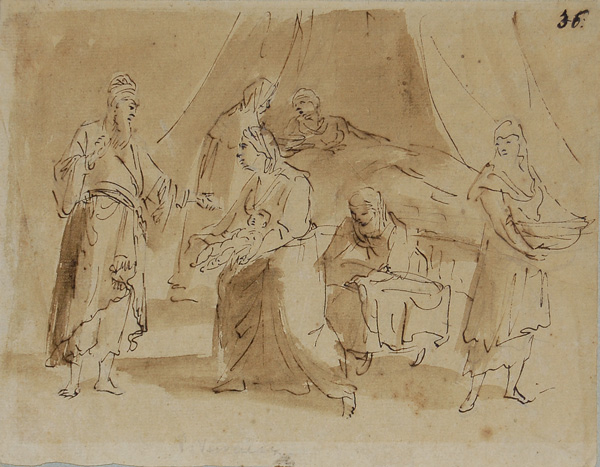 |
|
|
Paolo Cagliari called Veronese (c. 1528-1588), circle of, The Birth of the Virgin. Pen and brown ink on thin laid paper. This seems to have been in a collector's album of drawings at one point: it is numbered 36 in ink upper right and attributed to Veronese in pencil under the drawing left of center. In the background, St. Anne reclines in a canopied bed attended by a servant while others clean up after the birth. In the foreground, another servant shows the Virgin to Joachim. Image size: 155x200mm. Price: Please call or email for current pricing information.
|
|
|
 |
|
|
|
Venetian School, late 16th century, Kneeling woman holding a sea shell and looking over her right shoulder. Pen and ink on white laid paper with blue coating. Discoloration on dress. The black lines are stronger in the drawing and the discolored area in her dress is less prominent A very good drawing just back from conservation in less than ideal condition. Image size: 185x176mm (irregular) Price: Please call or email for current pricing information.
|
|
|
|
|
|
|
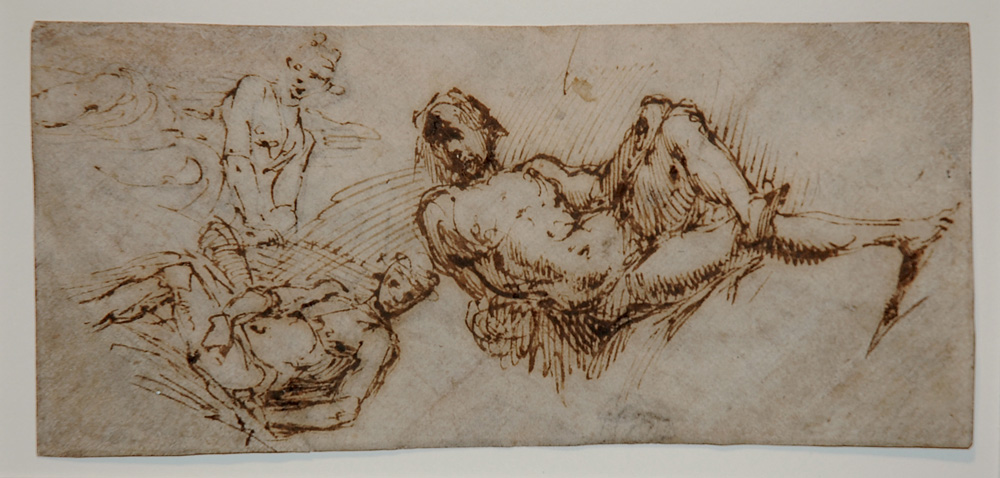 |
|
|
|
Alessandro Casolani (Italian, 1552-1606), Studies of reclining figures. Pen and brown ink on cream laid paper. On the verso, an early hand annotated the sheet "Michelangelo," probably not because he thought the drawing was by Michelangelo, but because he was reminded of Michelangelo's sculpture Aurora (Dawn) in the Medici Chapel in Florence (Charles De Tolnay, Michelangelo: The Medici Chapel Vol. 3 (Princeton: Princeton University Press, 1970), fig. 9-11). Casolani's sketches may be studies for a pediment or a lunette fresco. Image size: 87x187mm. Price: Please call or email for current pricing information.
Casolani was born in Mensano in the rural area of Casole d'Elsa between 1552 and 1553. Although he was probably not conscious of how good he was, his fame spread throughout Italy and abroad. His artistic formation took place in Siena under the guidance of the Arcangelo Salimbeni, where he developed, with some study companions (Cristofano Roncalli and the sculptor Prospero Roncalli, called the "Bresciano"), a passion for fantastic inventions and chromatic liveliness. Casolani studied for some years in Rome as well and succeeded, upon his return to Siena, in uniting the Sienese and Roman schools and become the"modern" Sienese painter who received the most prestigious commissions in Siena. His famous Adoration of the Shepherds for the Duomo di Siena dates to the ‘90s; he also worked for the Certosa di Pavia. A major retrospective was held in the Casole d'Elsa in Siena to honor one of the most important Sienese painters of the 16th century.
Bibliography: Alessandro Bagnoli, Patrizia La Porta, ed. Il Piacere del colorire: Artistic Itinerary of Alessandro Casolani 1552/53 - 1607: Guide to the exhibition held at Museo Archeologico e della Collegiata, Casole d'Elsa (Firenze: Centro Di, 2002.
|
|
|
|
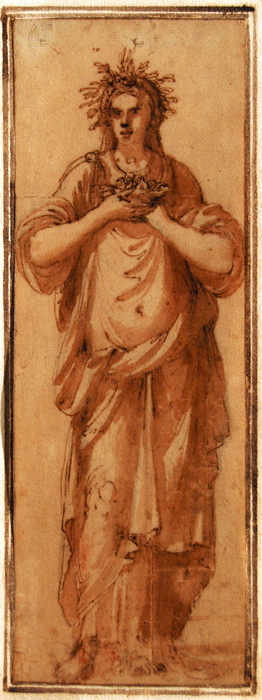 |
|
|
Federico Zuccaro (Italian, 1540-1609), Study of an mythological figure (Ceres). Pen and brown ink and wash on cream laid paper mounted on laid paper, c. 1561-63. Our drawing was originally attributed to Bernardino India (1528-1598) and Lionello Spada (1576-622), however, Suzanne Folds McCullagh (Chicago Art Institute) and L. M. Giles rejected this attribution in a conference with a previous owner on 15 October 1996. McCullagh suggested either Taddeo or Federico Zuccaro and dated it c. 1570. Further research has suggested that the drawing is related to Federico's Frieze with scenes from the Lives of Moses and Aaron in the Palazzo del Belvedere, Appartamento do Ritiro of Pope Pius IV. c. 1561-63. (See Carlo Pietrangeli, Paintings in the Vatican [Boston: Bulfinch Press, 1996], page 412, n. 391, 2nd stucco figure from the left). Federico had done a number of allegories (see e.g. his Allegory of Sloth in the Fogg Art Museum at Harvard [Mundy n. 43[ and some of the cycle of drawings in his Life of Taddeo, esp. n. 1, 3-4, 6, 11, and 15-16), and the drawing style supports the attribution. Image size: 272x97mm. Price: Please call or email for current pricing information.
|
|
|
|
|
|
|
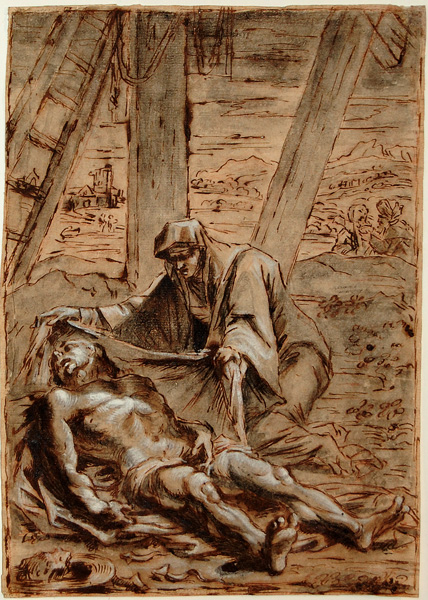 |
|
Federico Zuccaro (Italian, 1540-1609), Attributed to, The Lamentation. Pen and reddish brown ink and gray wash and red chalk with white heightening on cream laid paper. The Virgin Mary tenderly swaddles her dead son as she did her infant years earlier. The action takes place at the foot of the cross unnoticed by two men talking behind her to the right of the right cross. For works very close stylistically to this piece see E. James Mundy, with the assistance of Elizabeth Ourusoff de Fernandez-Gimenez, Renaissance Into Baroque: Italian Master Drawings by the Zuccari, 1550-1600 (Milwaukee: Milwaukee Art Center, 1989), plates 56, 82, 85, and 88. Image size: 232x165mm. Price: Please call or email for current pricing information.
|
|
|
|
|
 |
|
Francesco Vanni (Siena, 1563-1610), attributed: St. Francis receiving the stigmata. Pen and black ink, brown & gray wash, & white heightening, c. 1600. Drawing on fibrous buff laid paper. Vanni was the last great artist of the Sienese school and one of the principal masters of late Mannerist and early Baroque painting in Italy. Vanni was influenced first by his step-father Arcangelo Salimbeni and Federico Zuccaro; from 1585 on, Federico Barocci and the Carracci also contributed to his style. Image size: 307x227mm. Price: Please call or email for current pricing information.
|
|
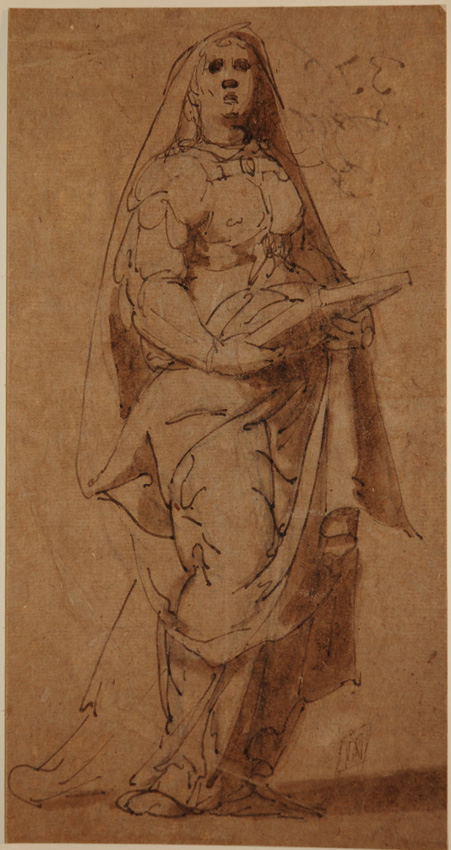 |
|
|
Genoese School (late 16th-century), A Sybil holding a book. Black chalk with white chalk on tan paper. A very strong drawing on laid paper mounted on a support sheet. The Sibyls were used in Michelangelo's Sistine Chapel ceiling frescoes as the pagan equivalents to the prophets of the Old Testament, divinely inspired, but seeing through a darker glass than the prophets. They show that all peoples had knowledge of the coming of the Messiah. Image size: 224x117mm. Price: Please call or email for current pricing information.
|
|
|
|
|
|
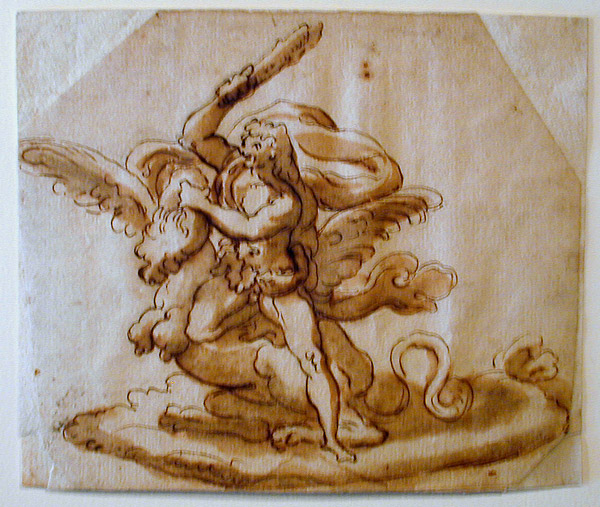 |
|
|
|
|
|
|
|
Cherubino Alberti (Borgio San Sepulchro 1553-1615 Rome), Hercules killing the Hydra. Pen and brown ink and wash on cream laid paper mounted on laid paper. The Hydra was one of the "impossible tasks" indirectly imposed on Hercules by Juno, who hated him because he was Jove's illegitimate son. Thy Hydra had the property of growing multiple new heads each time one was cut off. Hercules solved the problem by strangling its heads. There are two similar drawings in the Farnesia, Rome. See Kristina Hermann-Flore, 1983, nos. 106r and 174 v. Image size: 124x146mm Price: SOLD.
According to the Grove Art Dictionary, he was active as both a painter and a printmaker. The best known of the three sons of Alberto Alberti, he distinguished himself as a printmaker at an early age. One of his earliest prints, an etching of the Virgin and Child (1568; B. 149) shows his interest in Raphael as well as in contemporary Mannerist art. In Rome he studied with Cornelius Cort, whose swelling burin line he adopted to create pictorial effects of strong chiaroscuro. Between 1571 and 1575 he made several prints after Federico Zuccaro and Taddeo Zuccaro (B. 131, 136, 140, 159, 171, 176). During the next ten years he reached the height of his fame as a printmaker, producing engravings after Raphael, Michelangelo, Polidoro da Caravaggio and of ancient statues. His prints of Polidoro are particularly valued as documents of lost works. He also made prints from paintings by Andrea del Sarto, Rosso Fiorentino, Marco Pino, Pellegrino Tibaldi and Cristofano Gherardi. He made numerous original engravings, among them an Angel Supporting the Body of Christ (B. 139), which exemplifies his concern with graceful postures and ornamental draperies. In his later years he designed elaborate presentation prints, such as a portrait of Henry IV of France in an ornamental cartouche (B. 248) and a large Adoration of the Shepherds (B. 129) for Pope Clement VIII. His oeuvre includes over 180 prints.
|
|
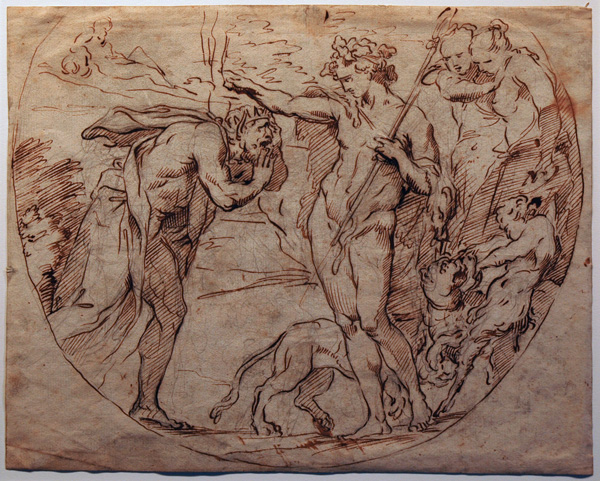 |
|
|
Annibale Carracci (Italian, 1560-1609), attributed, Apollo giving ass's ears to King Midas for prederring Pan's music to that of Apollo in a singing contest. Pen and brown ink and pencil on cream laid paper, c. 1603-1604. Annibale did drawings of Pan c. 1578-98 (National Gallery 2000, n. 49), and a number of other drawings of Apollo c. 1603-1604 for the Farnese Gallery in Rome. Image size: 270x335mm. Price: SOLD.
|
|
|
 |
|
|
|
Italian School, late 16th-early 17th century; circle of Bronzino?), Venus, Cupid, and a Satyr. Pen and brown ink and wash with white heightening on cream laid paper. In this very striking drawing, a satyr draws up the covers to reveal a sleeping Venus and her drowsy son Cupid. The work looks like a product of late Italian Mannerism. It is reminiscent of Bronzino, though quite different from his painting of the same subject. Provenance: Collection N. Hone (English painter, sales record in 1781, 1785); Zeitlin & Verbrugge, Los Angeles CA. Image size: 295x210mm. Price: SOLD.
|
|
|
|
|
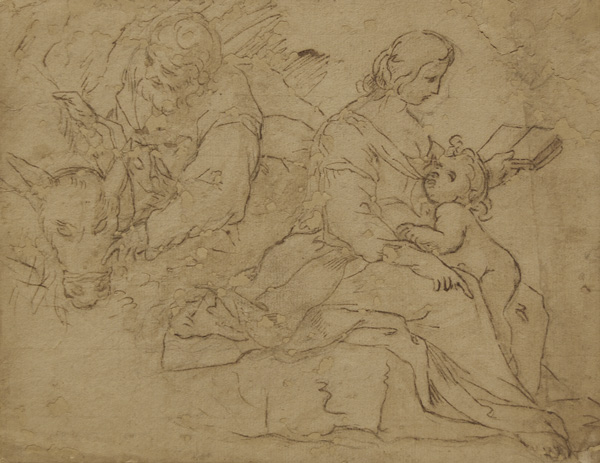 |
|
|
Ludovico Carracci (Bologna, 1555-1619), Rest on the Flight into Egypt. Pen and brown ink drawing on cream laid paper mounted on laid paper; a number of small holes in the paper have been made less unsightly by coloring the backing sheet. (It really isn't as bad to the eye as the photo makes it seem). There is a pencil attribution to Ludovico Carracci on the verso. Image size: 184x235mm. Price: Please call or email for current pricing information.
This work, and 4 others from our inventory, will be included in a show at the Haggerty Museum of Art at Marquette University in Milwaukee WI and will then travel to a second museum exhibition in 2013. Any purchase will be contingent upon the purchaser's willingness to accept delivery in 2014.
For more on Ludovico Carracci, please click here; for more on the Bolognese School in the 17th century inspired by Ludovico, Agostino, and Annibable Carracci and their assistants and followers, please click here.
|
|
|
|
|
Spaightwood Galleries, Inc.
To purchase, call us at 1-800-809-3343 (1-508-529-2511 in Upton MA & vicinity) or send an email to spaightwood@gmail.com
We accept AmericanExpress, DiscoverCard, MasterCard, and Visa.
We also accept wire transfers and paypal.
For directions and visiting information, please call. We are, of course, always available over the web and by telephone (see above for contact information). Click the following for links to past shows and artists. For a visual tour of the gallery, please click here. For information about Andy Weiner and Sonja Hansard-Weiner, please click here. For a list of special offers currently available, see Specials.
All works are sold with an unconditional guarantee of authenticity (as described in our website listing).
Copyright 2004-2017, Spaightwood Galleries, Inc.
Go back to the top of this page.
Visiting hours: Saturday 10:00 am to 5:00 pm and Sunday noon to 6:00 pm and other times by arrangement.
Please call to confirm your visit. Browsers and guests are welcome.
|
|
|
|
|
|
|
|
|
|
|
|
|
|
|
|
|
|
|
|
|
|
|
|
|
|
|
|
|
|
|
|
|
|
|
|
|
|
|
|
|
|
|
|
|
|
|
|
|
|
|
|
|
|
|
|
|
|
|
|
|
|
|
|
|
|
|
|
|
|
|
|
|






















